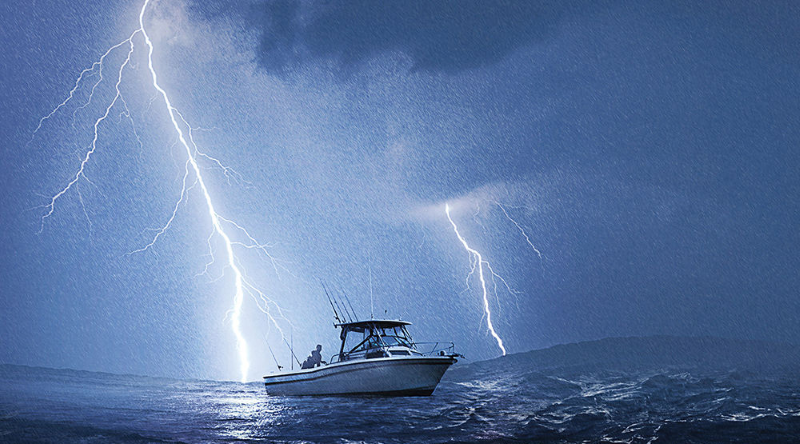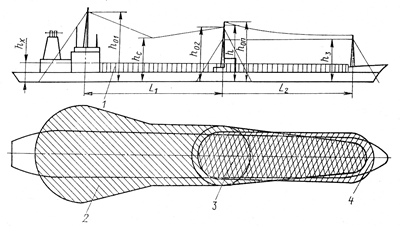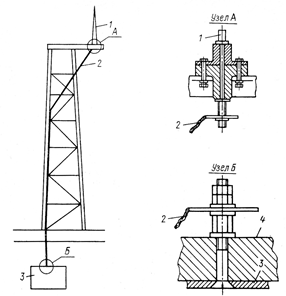
Introduction
Lightning is an electrical discharge in the atmosphere that occurs due to a potential difference inside a thundercloud or between a cloud and the ground. Lightning is considered to be one of the most dangerous natural phenomena, manifestations of which, in the form of a direct entry into an object or electrical induction, can lead to explosions, fires, and electric shock to people.
The place of a strike cannot be predicted. Given the fact that lightning currents always choose the shortest path to the ground with the least resistance, the potential objects for striking into them will be significantly elevated structures and their elements that have good conductivity and have a connection to the ground.
The secondary effect of lightning is the ability of the electromagnetic field to create significant potential in open circuits and metal structures (electrical wiring, pipelines, etc.), causing a malfunction in the operation of internal systems and damage to various kinds of electrical equipment.
To prevent undesirable consequences from lightning, a set of measures for lightning protection is organized.
Protection of the object from a direct strike of the lightning discharge is carried out with the use of lightning rods - devices that take the lightning strike over and divert the current through a safe path for the protected object into the ground. The lightning conductor usually consists of a lightning rod, a down conductor and a ground electrode. Depending on the type of construction of the lightning rod, the rod, catenary wire and mesh lightning rods are distinguished. To protect against secondary effects of lightning, in the form of electromagnetic pulses and overvoltages created by them, it is necessary to use fuses and overvoltage limiters - SPDs for the protection of DC and AC circuits, which will protect electronics, sensors and radio communication devices. It is also recommended to connect parallel-laid cables and pipes with metal bridges and ground cable and pipeline sheaths.
The effectiveness of lightning protection measures of the facility largely depends on the quality of the grounding system.
1. Peculiarities of grounding and lightning protection of marine vessels
As already noted, the lightning strike is most likely to occur on elevated objects, where the intensity of the electric field increases sharply. With respect to a vessel on water, this means that a lightning strike will most likely hit its mast. Considering the pitching, other protruding structures of the vessel, such as the crosspiece, the guy and the jackstay can be in the risk zone. When carrying out lightning protection of a marine vessel, it is important to take into account the peculiarity that it is surrounded by water on all sides and does not have towering buildings nearby. The task is to intercept and drain the lightning current along the safe path for the protected object into the water. Otherwise, there is a high probability of various damage to the vessel - from the sparking of cables to the disruption of the integrity of the bottom.
It is almost impossible to fully prevent the lightning strike into a ship that is in the open sea in a thunderstorm. A correctly organized lightning protection system will help, if not to excludee, but significantly reduce the possible damage to the ship and its equipment with a direct hit of the lightning strike.
However, in life, most of the damage to a ship in a thunderstorm is due to the appearance of electrical overvoltages in its metallic elements, as a result of a lightning strike into the water nearby. Under the influence of the electromagnetic pulses that arise in this case, the failure of the electronics, the electric shock to people and much less often the structural damage on the ship are possible. The implementation of protective measures against secondary impacts of lightning discharges, provides a full lightning protection of the vessel.
2. Solutions
2.1. Rules for lightning protection and grounding of marine vessels
With a reliable metal contact of the mast with the hull of the vessel made of metal, the installation of additional lightning-arresting equipment is not required. In this case, the ship's own vertical structures: metal masts, superstructure elements, etc. can act as a lightning rod (according to the "Rules of the Russian River Register (as amended on June 29, 2015)". Additional lightning rods should be used only in cases when own structural elements do not provide lightning protection.
On ships with a non-metallic hull, lightning protection is provided by the installation of separate lightning rods on mast tops grounded through the hull of the vessel. In fact, shipborne lightning protection devices do not differ from shore-based ones and also consist of a lightning rod, a down conductor and grounding.
A ship is considered protected from a direct lightning strike if the protection zones formed by the lightning rods cover all open areas on it. The probability of a lightning strike in the structural elements of the vessel within the protective zone is practically equal to zero. Protection zones of lightning rods must necessarily cover the locations of explosive mixtures, placement of explosive and fire dangerous goods, materials, equipment.

Figure 1. Arrangement of lightning protection zones on the ship: 1 - protected area; 2 - protection zone by the ship's own structural elements; 3 - zone of intersection of protection zones 2 and 4; 4 - protection zone with a catenary wire lightning rod
hx is the height of the protected area; h01 - design height of mainmast; Hс - height of the protection zone in the middle between the masts; h02 - design height of the cargo half-mast; h - distance (height) to the point where the catenary wire is most slack; hop - height of supports; h3 - height of the foremast; L1, L2 - the distance between the masts.
The absence of lightning protection devices for non-self-propelled vessels intended for the carriage of mineral cargoes operated without a crew is allowed. Antennas on the ship are installed below the lightning rods. Their operation as lightning rods is prohibited.
Connections of the elements of the lightning protection system of the vessel are made by welding or bolt clamps, providing the required contact area of at least 1000 mm2, and placed in the places of least mechanical impact available for inspection. The required value of the transient resistance between the ship's hull and the lightning rod is not more than 0.03 Ohm according to the "Rules of the Russian River Register (as amended on June 29, 2015)".
Execution of lightning-protective grounding is mandatory for all insulated steel structures, shields of electric networks and communication lines, pipelines and nodes for entering into explosive areas. It is necessary to provide protection against corrosion of lightning protection elements of the vessel and their connections.
2.2. How to protect ships from lightning
Each mast made of a non-conductive material (coal, wood) is equipped with a lightning rod in the form of a copper or steel rod (diameter 12 mm). The lightning rod is to be reliably grounded. Installation of other devices on it is not allowed.

Figure 2. Lightning rod on ships with a non-metallic hull: 1 - a lightning rod; 2 - down conductor; 3 - ground electrode; 4 - ship hull; 2 - protection zone by the ship's own structural elements; 3 - zone of intersection of protection zones 2 and 4; 4 - protection zone with a catenary wire lightning rod
The down conductor (divertive wire) is laid from the lightning rod outside of the mast or superstructure of the vessel, as far as possible from explosive areas, using a rod with a cross section of 70 mm2 or more - for copper and 100 mm2 or more - for steel wire. It is extremely important to carry out the down conductor rectilinearly, ensuring the least number of bends.
Vessels with a non-metallic hull are equipped with a separate down conductor, which is not connected to the protective and working grounding buses.
Ungrounded conductive parts located at the distance of 200 mm from the down conductors are to be connected to them, in order to avoid accumulation of the static potential.
The lightning rod and the metal hull of the vessel in the dock are connected to the shore grounding device.
2.3. How is grounding on marine vessels organized
When a lightning strike hits the mast, the current will tend to flow into the water through the hull of the vessel. On ships with a metal body, grounding is not required. The hull of steel and aluminum yachts serves as a "Faraday shield", protecting the ship's crew from the impact of an electric field.
All possible objects of lightning strike on wooden and plastic yachts are subject to mandatory grounding. The ground electrode is made of a copper or brass sheet with a thickness of at least 2 mm. The larger the grounding area is, the better protection it provides. The minimum permissible area of the grounding device for the vessel is 0.5 square meters.
The ship's ground electrode is immersed in the water. In this case, it is necessary to foresee that in case of draft and the largest permissible heel of the vessel, it will always have direct contact with water.
A metal keel that directly contacts water and is not insulated from it by dense layers of paint or fiberglass is considered to be the best grounding device. All grounding cables are output to it.
On ships with a composite hull, a metal stem or other metal structures painted with a conductive composition are used as a ground electrode, immersing them in water.
To equalize electrical potentials of metal parts: rails, baler, guy, jackstays, mast, etc., - they are connected with a cable into a single contour, which then must be grounded. Protection of the on-board electronics from the effect of static electricity is carried out in the same way.
The use of antistatic additives to plastics can eliminate the static electrization of dielectrics, increasing their surface conductivity. Grounding of ship equipment, namely metal casings and sheaths of low frequency cables, is performed using a conductive paint material forming a low volume resistance area on the surface of the painted product, which makes it possible to attach it to the grounding system.
3. Conclusion
It is almost impossible to exclude the possibility of lightning striking a vessel in the sea and not having other buildings nearby. In cases when the ship's own structural elements do not provide lightning protection for it, installation of lightning rods for each of the masts is required, with the mandatory grounding of all potential lightning strike objects. Not only a direct lightning strike is of great danger, but also the impact of electromagnetic pulses on the contours of vessels carrying flammable and explosive cargoes on board. Heating and possible sparking of an ungrounded contour, in this case, will cause a fire.
Despite the fact that a lightning strike can lead to serious consequences, a well thought out and high-quality protection against its primary and secondary effects will make any long-distance voyage safe.
All tanks intended for storage and transportation of flammable goods are subject to mandatory grounding. The equipment for receiving and draining flammable liquids, namely hoses and pipelines, is connected to those special buses, placed along and reliably connected to each other and to the hull of the vessel. Pipelines and oil pipelines located in open areas and passing through explosive premises are grounded every 10 m along their length to the hull of the vessel. Grounding of the pipelines of the upper deck, due to the possible accumulation of explosive gases there, is carried out every 30 m.
Do you need advice on the organization of grounding and lightning protection for your facility? Contact ZANDZ.com Technical Centre !
See also:
- Article by Professor E.M. Bazelyan "Lightning protection of residential and public buildings"
- Useful materials for grounding and lightning protection designers (articles, manuals, guidelines)
- Design of grounding and lightning protection (projects in DWG and PDF formats)
- Webinars for designers and electricians with the leading experts
- Lightning protection and grounding for large objects (diagrams and equipment lists)
- Principles of selection of surge arresters

